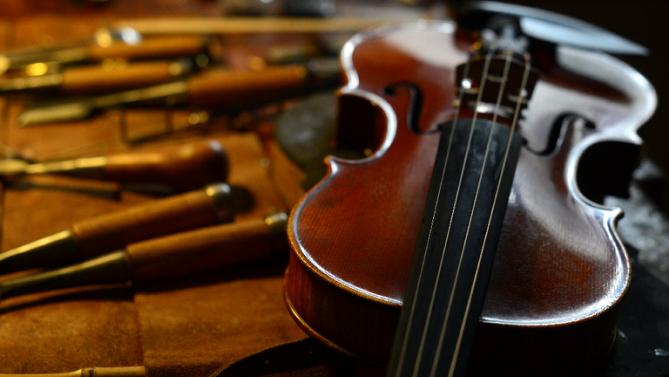Adams called his 40-minute work a dramatic symphony -- the term coined by Berlioz for an orchestra pushing the boundaries of narrative -- and the violin expresses the full range of emotion of Scheherazade.
Violinist Leila Josefowicz, a frequent collaborator of Adams, offered an intense performance as Scheherazade. Playing without notes, she visibly assumed the persona of her character, at times gazing steely with the poise of an opera singer.
Adams brought to stage a cimbalom which from the very start of the work offered a Middle Eastern tinge to music rooted in the Western classical tradition.
A lush tone emerges in the second movement as two harps portray Scheherazade falling in love. Adams, in what he acknowledged was meant to be a provocative move, suggested that the relationship may be with a fellow woman.
The third movement is entitled "Scheherazade and the Men with Beards." Zealots are represented arguing and condemning Scheherazade through blaring trombones, brusque movements of the string bass and imposing bass drums, as the violin responds with shriek-like arpeggios.
Scheherazade ultimately escapes and finds refuge, but the work ends not with a black-and-white triumph but with a gentle touch of the violin as if showing doubt about the future.
- A modern heroine -
Scheherazade -- depicted in "One Thousand and One Nights" as the queen who reads a tale each night to appease a jealous king who put to death his previous brides -- has been a favorite theme for Orientalist artists in the West who rejoiced in exotifying the Islamic world.
Musically, Scheherazade inspired works at the turn of the last century by the French composer Maurice Ravel and the Russian Nikolai Rimsky-Korsakov. Partially in tribute to the still-popular Rimsky-Korsakov composition, Adams entitled his dramatic symphony "Scheherazade.2."
Yet it is difficult to cast Adams as a simple neo-Orientalist. He has devoted himself to tackling complex contemporary events including the September 11 attacks and the dawn of the atomic age.
Most controversially, Adams wrote "The Death of Klinghoffer," a 1991 opera that explores the Israeli-Palestinian conflict through the killing of wheelchair-bound Jewish American Leon Klinghoffer by Palestinian hijackers on the Achille Lauro cruise ship.
The opera enraged some pro-Israel groups, especially as Palestinian characters make anti-Semitic remarks. Protesters repeatedly disrupted a production last year at the Metropolitan Opera, around the corner from the New York Philharmonic.
Adams said he was inspired to write the dramatic symphony after a visit to Paris where he saw an exhibition on Scheherazade at the Institut du Monde Arabe. He later reread "One Thousand and One Nights."
"I was absolutely shocked and appalled by how casual the brutality towards women was. And at the same time, I was looking at the Internet and seeing these images of women being oppressed by 'true believers,'" he said in brief remarks at the premiere.
In the program notes, Adams said that a Scheherazade of modern times could be the "woman in the blue bra" who was infamously beaten in Egypt's Tahrir Square or, outside the Arab world, Iranian student Neda Agha-Soltan who died in 2009 protests.
But he added: "We see examples -- if not quite so graphic, nonetheless profoundly disturbing -- from everywhere in the world, including in our own country and even on our own college campuses."
"Scheherazade.2" will be played in coming months around the world, including by the London Symphony Orchestra in October.
----------------------------------------------------------------------------------------------------------------
Violinist Leila Josefowicz, a frequent collaborator of Adams, offered an intense performance as Scheherazade. Playing without notes, she visibly assumed the persona of her character, at times gazing steely with the poise of an opera singer.
Adams brought to stage a cimbalom which from the very start of the work offered a Middle Eastern tinge to music rooted in the Western classical tradition.
A lush tone emerges in the second movement as two harps portray Scheherazade falling in love. Adams, in what he acknowledged was meant to be a provocative move, suggested that the relationship may be with a fellow woman.
The third movement is entitled "Scheherazade and the Men with Beards." Zealots are represented arguing and condemning Scheherazade through blaring trombones, brusque movements of the string bass and imposing bass drums, as the violin responds with shriek-like arpeggios.
Scheherazade ultimately escapes and finds refuge, but the work ends not with a black-and-white triumph but with a gentle touch of the violin as if showing doubt about the future.
- A modern heroine -
Scheherazade -- depicted in "One Thousand and One Nights" as the queen who reads a tale each night to appease a jealous king who put to death his previous brides -- has been a favorite theme for Orientalist artists in the West who rejoiced in exotifying the Islamic world.
Musically, Scheherazade inspired works at the turn of the last century by the French composer Maurice Ravel and the Russian Nikolai Rimsky-Korsakov. Partially in tribute to the still-popular Rimsky-Korsakov composition, Adams entitled his dramatic symphony "Scheherazade.2."
Yet it is difficult to cast Adams as a simple neo-Orientalist. He has devoted himself to tackling complex contemporary events including the September 11 attacks and the dawn of the atomic age.
Most controversially, Adams wrote "The Death of Klinghoffer," a 1991 opera that explores the Israeli-Palestinian conflict through the killing of wheelchair-bound Jewish American Leon Klinghoffer by Palestinian hijackers on the Achille Lauro cruise ship.
The opera enraged some pro-Israel groups, especially as Palestinian characters make anti-Semitic remarks. Protesters repeatedly disrupted a production last year at the Metropolitan Opera, around the corner from the New York Philharmonic.
Adams said he was inspired to write the dramatic symphony after a visit to Paris where he saw an exhibition on Scheherazade at the Institut du Monde Arabe. He later reread "One Thousand and One Nights."
"I was absolutely shocked and appalled by how casual the brutality towards women was. And at the same time, I was looking at the Internet and seeing these images of women being oppressed by 'true believers,'" he said in brief remarks at the premiere.
In the program notes, Adams said that a Scheherazade of modern times could be the "woman in the blue bra" who was infamously beaten in Egypt's Tahrir Square or, outside the Arab world, Iranian student Neda Agha-Soltan who died in 2009 protests.
But he added: "We see examples -- if not quite so graphic, nonetheless profoundly disturbing -- from everywhere in the world, including in our own country and even on our own college campuses."
"Scheherazade.2" will be played in coming months around the world, including by the London Symphony Orchestra in October.
----------------------------------------------------------------------------------------------------------------









 Home
Home Politics
Politics











